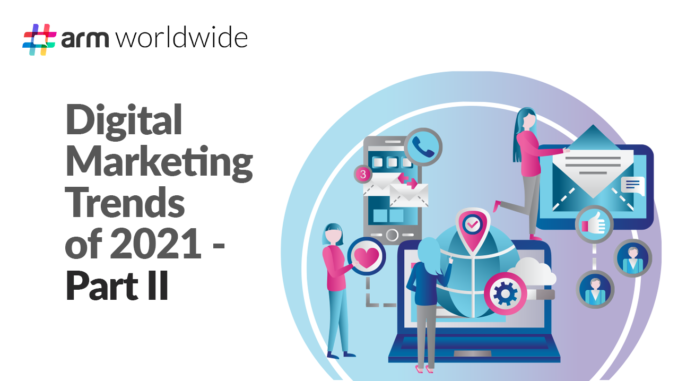
Over the years, the digital marketing landscape has undergone several transformations for easier communication and better experience with the audience it targets. It is a continuous evolution process, and it brings in the much-needed change to keep pace with the trends. To expand their creativity and boundaries, businesses need to harness and use these new technologies, techniques, and innovations. Last week in Digital, we spoke about the fundamental digital marketing trends that we can expect to see in the upcoming year. This week, we will talk about those trends that will pick up pace in the year 2021 and are an absolute must for your businesses to adopt so that performance is at its best.
AI will induce hyper personalisation
In 2021, Ad creating platforms and software will drive hyper personalisation with their advertisements. Personalised things will become hyper personalised as brands will use more and more information about the customer by analysing their profile data, purchasing behaviour, location, demography, real-time behavioral data, and so on, to make recommendations and suggestions that best suit their time and requirement. Customers today are very technology-friendly, but they also face a time crunch owing to their busy routines. With hyper personalisation, this will become easier because AI will enable them to see the right content at the right time. AI will further help analyse written content for hyper-targeting customers keeping the readability score in mind. Customers will feel that the brand really cares about them.
Online shoppers will adopt voice-based search
Many businesses will tap into the e-commerce market because it is lucrative, and most of the millennials today prefer shopping online. Soon enough, rather than typing the words, they will be giving voice commands to their AI voice assistants to complete a purchase for them. The power of voice search can already be seen making its presence felt, and it is assumed to become the in-thing in 2021. It will personalise the user experience by maintaining a record of the individual’s preferences, save time, and will also make it much easier for the user to find a product online. The game, too, will change accordingly so that voice-based searches can provide optimum results. Furthermore, customers will be more likely to give feedback, thanks to voice-aided typing.
Interactive ads will take over static ads
Static ads will receive a fine-tuning to turn into something more dynamic, that is, interactive ads, and thereby, become more engaging for the customers. Interactive ads will enable customers to see content that is relevant to their interests and needs. Rather than passively consuming an advertisement, they will now actively participate in its presentation. The usual redirecting to websites and apps will be avoided, and this will also help improve brand recall. People today prefer interactions and, therefore, look for things in an advertisement that will add value to their lives. Static ads will not be able to cater to this requirement, but interactive ads, on the other hand, will provide them with that immersive experience. Furthermore, it is said that interactive ads can increase customer engagement by 47 percent compared to traditional ads.
AR & VR will have new Avatars
AR and VR techniques can be used effectively by both B2B and B2C businesses for their marketing and sales strategies. It is expected that more than 61 percent of consumers will buy from their retailers via augmented reality services or virtual reality services. This particular trend will receive all the more hype owing to the Coronavirus pandemic. By trying on things from the comfort of one’s home, conversion rates will be much higher. Virtual reality will club action and experience together, thereby making the purchase process wholesome – providing this kind of digital experience can become a game-changer for many brands and businesses. Not just this, but AR will also help with a brand’s promotional events, and this aspect will receive a big push in the coming year.
Employees as the brand’s spokesperson
The year 2021 will see employees engaging positively with their brands on social media. Working remotely has led to the invention of several new methods. Employees will help spread the word and the brand message by being socially active, and this will have a much more significant and far-reaching impact. Brand videos featuring employees will receive the required traction because they will be speaking as internal members of the brand to the external audience – a massive boost for building that trust factor. After all, the information will be raw and unfiltered, making it more believable; and also add authenticity because the information is not coming from the company but in real-time from its people. This method will help bring in a quality talent pool for the organizations and further highlight its goals and values.
All in all, these are some of the that are expected to give your brands the much-needed makeover in the year 2021. Keeping track of the changes and adapting these methods will help get the brand across to the masses in both an efficient and effective manner.
Download the PDF versionRequest Consultation
The post Digital Marketing Trends of 2021 – Part II appeared first on #ARM Worldwide.

Leave a Reply